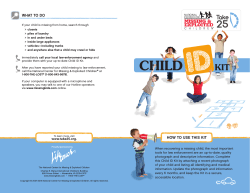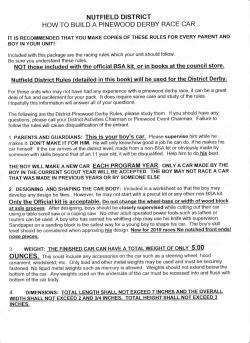
Floods-What to Do Brochure
Floods What to do? Know the risks Make a plan Get a kit Our partners This publication was produced by Public Safety Canada in collaboration with: Canada Mortgage and Housing Corporation (CMHC), The Canadian Red Cross, Natural Resources Canada, and St. John Ambulance. Scan this code with your mobile device to visit www.GetPrepared.ca. This publication is also available in multiple formats (audio, braille, large print, and e-Text). To order, please call: 1 800 O-Canada (1-800-622-6232); TTY: 1-800-926-9105. © Her Majesty the Queen in Right of Canada 2011 Cat. No.: PS48-9/1-2011E-PDF ISBN: 978-1-100-17026-8 Printed in Canada TABLE OF CONTENTS INTRODUCTION � � � � � � � � � � � � � � � � � � � � � � � � � � � � � � � � � � � � � � � � � � � � � � � � � � � � � � � � � � � � � � 1 STEP 1: KNOW THE RISKS AND GET PREPARED � � � � � � � � � � � � � � � � � 2 Preparing for a Flood � � � � � � � � � � � � � � � � � � � � � � � � � � � � � � � � � � � � � � � � � � � � 2 During a Flood � � � � � � � � � � � � � � � � � � � � � � � � � � � � � � � � � � � � � � � � � � � � � � � � � � � � � � 4 After a Flood � � � � � � � � � � � � � � � � � � � � � � � � � � � � � � � � � � � � � � � � � � � � � � � � � � � � � � � � � 5 STEP 2: MAKE AN EMERGENCY PLAN � � � � � � � � � � � � � � � � � � � � � � � � � � � � � � � 7 STEP 3: GET AN EMERGENCY KIT � � � � � � � � � � � � � � � � � � � � � � � � � � � � � � � � � � � � � 8 RESOURCES � � � � � � � � � � � � � � � � � � � � � � � � � � � � � � � � � � � � � � � � � � � � � � � � � � � � � � � � � � � � � � � � � � 10 National Resources � � � � � � � � � � � � � � � � � � � � � � � � � � � � � � � � � � � � � � � � � � � � � 10 Provincial and Territorial Resources � � � � � � � � � � � � � � � � � � � � � 11 i INTRODUCTION Floods are the most frequent natural hazards in Canada, and the most costly in terms of property damage. Floods can occur in any region, in the countryside or in cities. In the past, floods have affected hundreds of thousands of Canadians. They can occur at any time of the year and are most often caused by heavy rainfall, rapid melting of a thick snow pack, ice jams, or more rarely, the failure of a natural or human-made dam. All Canadian rivers experience flooding at one time or another. The potential for flood damage is particularly high where there is development on low-lying, flood-prone lands. Flash or sudden flooding, in which warning time is extremely limited, can result from other causes such as hurricanes, violent rainstorms, or the bursting of dams. Though all levels of government are working to reduce the impact of floods, individuals also play an important role. Everyone has a responsibility to protect their homes and their families. You can greatly lessen the impact of a flood by taking the time to prepare in advance. This involves three basic steps: 1.Find out what to do before, during, and after a flood. 2.Make a family emergency plan, so that everyone knows what to do, and where to go in case of an emergency. 3.Get an emergency kit, so that you and your family can be self-sufficient for at least 72 hours during a flood. Planning for a flood will also help prepare you for many other types of emergencies. After reading this guide, keep it in a handy spot, such as in your emergency kit. www.GetPrepared.ca 1 STEP 1: KNOW THE RISKS AND GET PREPARED To get prepared for a flood, you should know the risks specific to your community and your region to help you better prepare. To find out what the hazards are in your region, visit the “Know the risks” section of the GetPrepared.ca website. Preparing for a Flood To reduce the likelihood of flood damage •Put weather protection sealant around basement windows and the base of ground-level doors. •Install the drainage for downspouts a sufficient distance from your residence to ensure that water moves away from the building. •Consider installing a sump pump and zero reverse flow valves in basement floor drains. •Do not store your important documents in the basement. Keep them at a higher level, protected from flood damage. 2 Floods — What to do? If a flood is forecast •Turn off basement furnaces and the outside gas valve. •Take special precautions to safeguard electrical, natural gas or propane heating equipment. •If there is enough time, consult your electricity or fuel supplier for instructions on how to proceed. •Shut off the electricity only if flooding has not yet begun and the area around the fuse box is completely dry. Stand to the side of the breaker panel and look away from the panel when switching the power off. Have a flashlight with you. If flooding is imminent •Move furniture, electrical appliances and other belongings to floors above ground level. •Remove toxic substances such as pesticides and insecticides from the flood area to prevent pollution. •Remove toilet bowls and plug basement sewer drains and toilet connections with a wooden stopper. •Disconnect eavestroughs if they are connected to the house sewer. •In some cases, homes may be protected with sandbags or polyethylene barriers. Follow instructions from local emergency officials. •Do NOT attempt to shut off electricity if any water is present. Water and live electrical wires can be lethal. Leave your home immediately and do not return until authorities indicate it is safe to do so. www.GetPrepared.ca 3 During a Flood •Listen to the radio to find out what areas are affected, what roads are safe, where to go and what to do if the local emergency team asks you to leave your home. •Keep your emergency kit close at hand, in a portable container such as a duffel bag, backpack, or suitcase with wheels. If you need to evacuate •Vacate your home when you are advised to do so by local emergency authorities. Ignoring such a warning could jeopardize the safety of your family or those who might eventually have to come to your rescue. •Take your emergency kit with you. •Follow the routes specified by officials. Don’t take shortcuts. They could lead you to a blocked or dangerous area. •Make arrangements for pets. •Time permitting, leave a note informing others when you left and where you went. If you have a mailbox, leave the note there. Never cross a flooded area •If you are on foot, fast water could sweep you away. •If you are in a car, do not drive through flood waters or underpasses. The water may be deeper than it looks and your car could get stuck or swept away by fast water. •Avoid crossing bridges if the water is high and flowing quickly. •If you are caught in fast-rising waters and your car stalls, leave it and save yourself and your passengers. 4 Floods — What to do? After a Flood Re-entering your home •Do not return home until authorities have advised that it is safe to do so. •If the main power switch was not turned off prior to flooding, do not re-enter your home until a qualified electrician has determined it is safe to do so. •Use extreme caution when returning to your home after a flood. •Appliances that may have been flooded pose a risk of shock or fire when turned on. Do not use any appliances, heating, pressure, or sewage system until electrical components have been thoroughly cleaned, dried, and inspected by a qualified electrician. •The main electrical panel must be cleaned, dried, and tested by a qualified electrician to ensure that it is safe. •Depending on where you live, your municipal or the provincial inspection authority is responsible for the permitting process required before your electric utility can reconnect power to your home. Ensure building safety •Make sure the building is structurally safe. •Look for buckled walls or floors. •Watch for holes in the floor, broken glass and other potentially dangerous debris. www.GetPrepared.ca 5 Water •Flood water can be heavily contaminated with sewage and other pollutants. It can cause sickness and infections. •If through colour, odour or taste you suspect that your drinking water has been contaminated, don’t drink it. •Household items that have been flood-damaged will have to be discarded according to local regulations. Documentation •Store all valuable papers that have been damaged in a freezer until needed. (After your cleanup, consult your lawyer to determine whether flood-damaged documents, or just the information in them, must be retained). •Record details of flood damage by photograph or video, if possible. •Register the amount of damage to your home with both your insurance agent and local municipality immediately. 6 Floods — What to do? STEP 2: MAKE AN EMERGENCY PLAN Every Canadian household needs an emergency plan. It will help you and your family to know what to do in case of an emergency. Remember, your family may not be together when a flood or other emergency occurs. Start by discussing what could happen and what you should do at home, at school or at work if an emergency happens. To be prepared, make a list of what needs to be done ahead of time. Store important family documents, such as birth certificates, passports, wills, financial documents, insurance policies, etc. in waterproof container(s). Identify an appropriate out-of-town contact that can act as a central point of contact in an emergency. Write down and exercise your plan with the entire family at least once a year. Make sure everybody has a copy and keeps it close at hand. For more information on making an emergency plan, call 1 800 O-Canada or visit www.GetPrepared.ca to download or complete an emergency plan online. www.GetPrepared.ca 7 STEP 3: GET AN EMERGENCY KIT In an emergency you will need some basic supplies. You may need to get by without power or tap water. Be prepared to be self-sufficient for at least 72 hours. You may have some of the items already, such as a flashlight, battery-operated radio, food and water. The key is to make sure they are organized and easy to find. Would you be able to find your flashlight in the dark? Make sure your kit is easy to carry. Keep it in a backpack, duffel bag or suitcase with wheels, in an easy-to-reach, accessible place, such as your front hall closet. Make sure everyone in the household knows where the emergency kit is. Basic emergency kit •Water — at least two litres of water per person per day. Include small bottles that can be carried easily in case of an evacuation order. •Food that won’t spoil, such as canned food, energy bars and dried foods (remember to replace the food and water once a year). •Manual can opener. •Wind-up or battery-powered flashlight (and extra batteries). •Wind-up or battery-powered radio (and extra batteries). •First aid kit. •Special items such as prescription medications, infant formula and equipment for people with disabilities. 8 Floods — What to do? •Extra keys to your car and house. •Cash in smaller bills, such as $10 bills and change for payphones. •A copy of your emergency plan and contact information. You can purchase a pre-packaged emergency kit from the Canadian Red Cross at www.redcross.ca. Visit www.GetPrepared.ca or call 1 800 O-Canada for a list of additional emergency kit items, including a car emergency kit. www.GetPrepared.ca 9 RESOURCES National Resources Public Safety Canada – Other publications: •Earthquakes — What to do? •Emergency Preparedness for Farm Animals •Power Outages — What to do? •Severe Storms — What to do? •Your Emergency Preparedness Guide •Emergency Preparedness Guide for People with Disabilities/ Special Needs For more emergency preparedness information or to order brochures, visit www.GetPrepared.ca or follow @Get_Prepared on Twitter. Canada Mortgage and Housing Corporation — 1-800-668-2642 or visit www.cmhc.gc.ca Canadian Red Cross — www.redcross.ca Natural Resources Canada — www.nrcan.gc.ca St. John Ambulance — www.sja.ca 10 Floods — What to do? Provincial and Territorial Resources For regional or local information on emergency preparedness, contact your emergency management organization as follows: Alberta Alberta Emergency Management Agency Telephone: (780) 422-9000/Toll-free: 310-0000 www.aema.alberta.ca British Columbia British Columbia Provincial Emergency Program Telephone: (250) 952-4913/Emergency toll-free: 1-800-663-3456 www.pep.bc.ca Manitoba Manitoba Emergency Measures Organization Telephone: (204) 945-4772/Toll-free: 1-888-267-8298 www.manitobaemo.ca New Brunswick New Brunswick Emergency Measures Organization Telephone: (506) 453-2133/Toll-free 24-Hour line: 1-800-561-4034 www.gnb.ca/cnb/emo-omu Newfoundland and Labrador Newfoundland and Labrador Fire and Emergency Services Telephone: (709) 729-3703 www.ma.gov.nl.ca/ma/fes www.GetPrepared.ca 11 Northwest Territories Northwest Territories Emergency Measures Organization Telephone: (867) 873-7538/24-Hour line: (867) 920-2303 www.maca.gov.nt.ca/emergency_management/index.htm Nova Scotia Nova Scotia Emergency Management Office Toll-free 24-Hour line: 1-866-424-5620 www.gov.ns.ca/emo Nunavut Nunavut Emergency Management Telephone: (867) 975-5403/Toll-free 24-Hour line: 1-800-693-1666 cgs.gov.nu.ca/en/nunavut-emergency-management Ontario Emergency Management Ontario Telephone: (416) 314-3723/Toll-free 24-Hour line: 1-877-314-3723 www.ontario.ca/emo Prince Edward Island Prince Edward Island Emergency Measures Organization Telephone: (902) 894-0385/After hours: (902) 892-9365 www.peipublicsafety.ca Quebec Quebec — Ministère de la sécurité publique Telephone (toll-free): 1-866-644-6826 General information (Services Québec): 1-877-644-4545 www.securitepublique.gouv.qc.ca 12 Floods — What to do? Saskatchewan Saskatchewan Emergency Management Organization Telephone: (306) 787-9563 www.cps.gov.sk.ca/SaskEMO Yukon Yukon Emergency Measures Organization Telephone: (867) 667-5220 Toll-free (within the Yukon): 1-800-661-0408 www.community.gov.yk.ca/emo www.GetPrepared.ca 13 www.GetPrepared.ca
© Copyright 2025




















